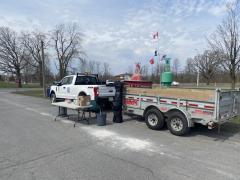Did you know that Earth Day is April 22 and the Provincial Day of Action on Litter is on May 14? Well, now you do! The South Dundas Recreation Department wants to support you, your classmates, sports team, community organizations, or business, if you want to get involved and help clean up litter in South Dundas!

How to get involved:
1. Pick any day between April 22 - May 14
2. Fill out the online registration form.
Find the online registration form here.
3. South Dundas Recreation will provide you with gloves, bags, and lend you garbage pickers and safety vests.
4. Let us know where you left your collected litter, we will come pick it up and dispose of it.
Cleanup Site Ideas:
- Parks
- Pathways
- Roadsides
- Sidewalks
Information provided by www.earthday.org/
April 22 is Earth Day
Join us to honor and celebrate our remarkable planet on this extraordinary day. Earth Day is a reminder of the importance of environmental conservation and sustainability, encouraging us to come together and take action for a healthier planet and brighter future.
Through various events, toolkits, and initiatives, we aim to raise awareness, inspire change, and foster a deeper connection with nature. Let's unite in our efforts to protect the Earth today and for generations to come. Together, we can make a meaningful impact and create a more sustainable world.
- 1970 was the worlds first Earth Day!
- 1 Billion individuals mobilized for the future of the planet.
- 75,000+ partners working towards positive action.
This content was provided by ontario.ca/actonlitter
The Provincial Day of Action on Litter is celebrated on the second Tuesday of May each year in Ontario.
We are taking action to reduce the amount of waste going to landfills or becoming litter by bringing awareness to the impacts of waste on our environment and encouraging people to take action at home and in their community to help keep our environment clean and healthy for generations to come.
There are actions we can all take to put litter in its proper place. You can do this by:
- Reducing waste: giving old products new life instead of throwing them away. For example, using old containers for storage or supporting second-hand clothing stores as opposed to buying new.
- Diverting waste: recycling or composting materials when and where possible to divert waste away from landfills. For example, by using your blue and green bins. When cleaning up litter, make sure you properly separate out recyclables.
- Preventing waste and litter: stopping waste before it's created, and before it has the chance to become litter. For example, by choosing to buy goods with less packaging or by bringing a reusable cup to take-out establishments that accept them.
- Cleaning up litter: helping to keep your community clean by picking up and properly disposing of litter, or by organizing a community litter cleanup for others. Our Litter Cleanup Guides have more information on how to organize a safe and successful cleanup.
- Properly disposing of waste: making sure anything that does belong in the trash, is securely placed in garbage bins to help keep our neighbourhoods clean.
Why it matters:
We generate nearly one tonne of waste per person every year in Ontario. It is estimated that almost 10,000 tonnes of plastic debris enter Ontario’s lakes and rivers each year.
In Ontario:
- just over 50% of the waste we divert is through blue box, green bins and leaf and yard waste collection programs
- 70% of all waste materials from residential, commercial, industrial and institutional locations end up in landfills, and 30% are diverted
Food and organics make up one third of the waste we generate. When food and organic waste breaks down in landfills it produces harmful greenhouse gases.
Ontario’s greenhouse gases from solid waste in landfills totaled 6 million tonnes CO2e (carbon dioxide equivalent) in 2020. Waste that doesn’t get recycled or go to landfills ends up as litter in our environment, which can have a negative effect on local ecosystems.
Litter along our shorelines, in our green spaces and on our streets can spill into our waterways and break down into micro-plastics in the environment, which can hurt or even kill wildlife and damage ecosystems.
Plastics in the environment
- It is estimated that almost 10,000 metric tonnes of plastic waste enters our lakes and rivers each year from Canada and the United States.
- Microplastics (plastics that are smaller than 5mm) are found in some areas of the Great Lakes in concentrations greater than those reported in oceans
Food and organic waste
- When food or organics end up in landfills, they release methane gas – a substance with a global warming potential twenty-five times greater than CO2.
- When we send our food and organics to landfills, we lose the opportunity to recover the value of nutrients which could be returned to the earth where they can be used to benefit and support healthy soils and reduce GHG emissions.
What Ontario is doing
The province is working to reduce, prevent and divert waste and litter, keeping it out of landfills and away from our natural spaces. Together with our municipal and industry partners, we are:
- Implementing our Food and Organic Waste Policy Statement to reduce and divert food and organic waste, create consistent rules for what goes in green bins, and create opportunities for the rescue of surplus food and redistribution to those in need.
- Making producers responsible for the waste they create by transitioning oversight of the blue box program from municipalities to producers.
- Making producers responsible for managing batteries that are recycled.
- Modernizing the hazardous waste reporting system so it can be tracked more efficiently and properly reported.
What you can do
Your actions matter. Recycling one aluminum can saves enough energy to run a TV for three hours, or one game of hockey. Almost every plastic item we’ve made since the 1950s is still in our environment.
Actions you can take:
- Donating gently used plastic toys and clothing instead of throwing them away.
- Using your own reusable dinnerware instead of disposable plastic or paper plates.
- Swapping your plastic water bottle or takeout coffee cup for a reusable one when you’re on the go.
- Recycling materials instead of throwing them in the garbage.
- Using bins to properly dispose of waste, and when bins are full or you can’t locate one, taking waste home with you for proper disposal.
- Organizing a community clean up or taking a moment to cleanup litter when you see it.
- Adopting a local greenspace, sidewalk or shoreline to help keep it litter-free.
- Reporting litter hot spots and illegal dumping – see the below ‘Report littering or illegal dumping in your community’ section for more information on how to do so.
Tips for around the house
- Become an expert on what goes in the green bin and blue box in your municipality.
- Clean out the leftover food or beverages from jars, bottles, plastic containers and other recyclables before putting them in your blue box. If containers are dirty, they may not get recycled.
- Use up leftover produce in your fridge by making a batch of soup or stir fry.
- Put perishable foods on the top shelf of your fridge so you can keep an eye on them and use them up.
- Make a zero-waste air freshener with a few simple household ingredients.
- Upcycle your old jeans into a DIY dog toy.
Tips for around your backyard:
- Create your own compost station outside for your garden soil.
- Use old towels to clean your outside windows, table tops and chairs.
- Create a seed nursery with toilet paper rolls before planting.
- Reuse cracked or damaged ceramics as flower pots.
- Create a “bee hotel” using things from around the house.
- Prevent food waste by growing what you need. Learn how to grow your own sprouts.
Tips when grocery shopping:
- Avoid food waste by planning your meals in advance and buying groceries for your weekly recipes.
- Purchase beeswax food wraps instead of plastic wrap.
- Purchase reusable straws instead of plastic straws.
- Mason jars are handy and can be reused for multiple purposes. Check out our Mason Jar Salad recipe.

